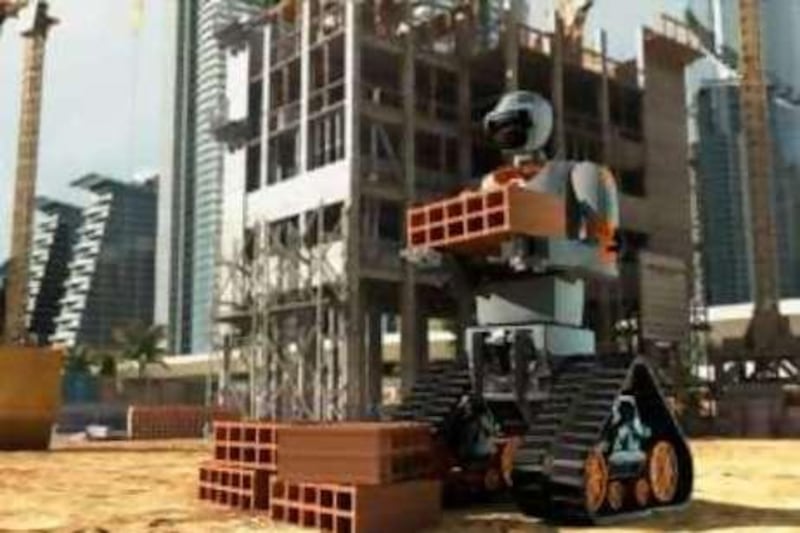A new humanoid robot was launched in Abu Dhabi this week. It was a reminder that robotics, like flying cars and the much-desired hoverboard, is a technological pursuit far better developed in the popular imagination than in reality. Although film and television have long portrayed the imminent arrival of walking, talking, intelligent machines, such a development remains many decades away. But that has not discouraged huge investment in the sector.
So huge, in fact, that it is now big business. The technology research company, ABI, has predicted the global market for personal robotics - devices that help in the home - to be worth US$15 billion (Dh55bn) by 2015. The International Federation of Robotics (IFR) has reported that more than 1.1 million industrial robots were sold in 2006, along with 1.2 million domestic robots. It estimates that more than five million functioning robots are currently in use across the world. To underline the scope and development in the sector, the South Korean government has set a target for every household to have a robot by 2020.
But more significantly, the US congress has mandated that by 2015, one-third of all military vehicles - land, air and sea - must be unmanned. Businesses with proven concepts in robotics will face a boom in spending of unprecedented proportions. Already many commercial devices currently on the market are at the cutting edge of a global race to develop these smart machines. In homes, such devices are likely to be found vacuuming the carpet or mowing the lawn, both areas where robotic devices have made significant inroads into the market. In industry, the advanced manufacturing sector was an early, eager convert to robotics. Cars, microchips, televisions and aeroplanes are now all made with the help of electronic arms and computerised milling machines.
But these functional machines bear no resemblance to the beloved robots of the imagination - C-3PO, the good-natured droid of Star Wars, or Marvin from The Hitchhikers Guide To The Galaxy. In 1920, when the Czech writer Karel Capek was working on a play involving a factory that builds human-like machines, he needed a word to describe the novel concept of an artificial person. He chose robot, a derivative of robota, a word in Czech, Slovak and Polish that literally translates as a serf or a hard manual labourer. Since then, technology has failed to keep up with the vision of what a robot should be. "We've been seeing walking robots on the screen for decades, but none of it was real - walking is incredibly complicated," said Professor Noel Sharkey, an international authority on robotics. "What people have to understand is that there have only really been walking robots for the last 10 years. So developments such as Reem B [the Middle East's newest, most advanced robot] are right at the cutting edge."
The quest to build an intelligent android is a long, slow-moving process. Comparisons can be drawn with the Formula One car industry. Although hundreds of millions of dollars are invested each year in motor racing, that does not result in a mass-produced car that can be used on roads across the globe. But that investment does drive research and development, which will eventually benefit the industry.
The strong, lightweight composite materials now used in car bodies and engines were originally developed in Formula One, as were a host of safety, efficiency and engine management technologies. So despite the slow progress of developing a human-like machine, robotics has spun off a number of innovations that are changing the way people live and work. A company that has had more success than any other in making robotics consumer-friendly has been iRobot. The firm, which was founded by the robotics graduates Rodney Brooks, Colin Angle and Helen Greiner, of the Massachusetts Institute of Technology, has sold 3.2 million home robots since the it launched in 1990.
The machines developed by iRobot have done everything from vacuuming floors to dismantling roadside bombs in Iraq. One of the company's products explored areas of Egypt's Great Pyramid of Giza that had never been seen modern-day people. But its most successful product has been the Roomba, a vacuum cleaner that works independently. It navigates its way around a room, cleaning carpets and avoiding obstacles. The Roomba is careful to find its way back to a charging station before its battery loses power.
American homeowners have fallen in love with the device to the delight of its developers. In a recent survey, 18 per cent of respondents said they intended to buy the Roomba when they next purchased a vacuum cleaner. But the potential of the robot in the home is likely to be overshadowed by its application in military and industrial sectors. Executives at iRobot talk about the future of a "roboticised battle space" where unmanned aerial vehicles communicate with ground-based machines that can search buildings, locate the origin of sniper fire and enter risky areas in advance of soldiers.
The company already has more than 1,500 ground-based robots in active use with the US military, and believes such a relationship will help it take a major share of future spending in the area. "Our track record of delivering on contracts, our reputation, our infrastructure [will] position us well to lead in this market," said Helen Greiner, the iRobot chairman, in a recent conference call with investors.
PAL Technology, the Abu Dhabi-based company that developed the Reem B robot that was unveiled this week, stressed that its goal was to make a machine that could help people. No mention of military possibilities was made at its launch. During the Reem B demostration, slides were shown illustrating how humanoid robots could act as guides, taking visitors on futuristic tours of the new museums planned for Saadiyat Island or the carbon-free Masdar City.
A robot guide could be programmed with an encyclopaedic knowledge of its environment and would be as big a draw for tourism as the paintings on the walls of the Guggenheim and Louvre museums. The impetus behind Reem B's development, according to PAL Technology, was a desire of Sheikh Tahnoon bin Zayed, the chairman of The Royal group - the parent company - to see a robot that could help care for the sick and the elderly.
Such a vision is an important economic stimulant to the robotics industry in Japan, where an ageing, technology-friendly population are facing a future with fewer young people to care for them. Mitsubishi, which is one of the country's largest industrial conglomerates, has released Wakamuru, a bright yellow carer robot that can act as a companion for the elderly. It is equipped with a web camera that allows family members or doctors to communicate with its owner, even providing basic medical checkups. It can also remind its owner to take daily medication and help him or her with household tasks.
At US$10,000 and upwards, Wakamuru is not cheap. But it is a fraction of the cost of a full-time carer and in a wealthy, ageing country such a product has been embraced by consumers. Yet in the UAE, it might be a different story. Robot's may have a major role to play in replacing low-cost labour in the building industry. When Reem B's developers displayed a slide showing the robot diligently hauling a load of bricks across a construction site, gasps and murmurs of approval emerged from the assembled crowd of dignitaries and businessmen. "I want 10,000 of them," one stunned guest said. Science fiction today, but maybe science fact tomorrow.





